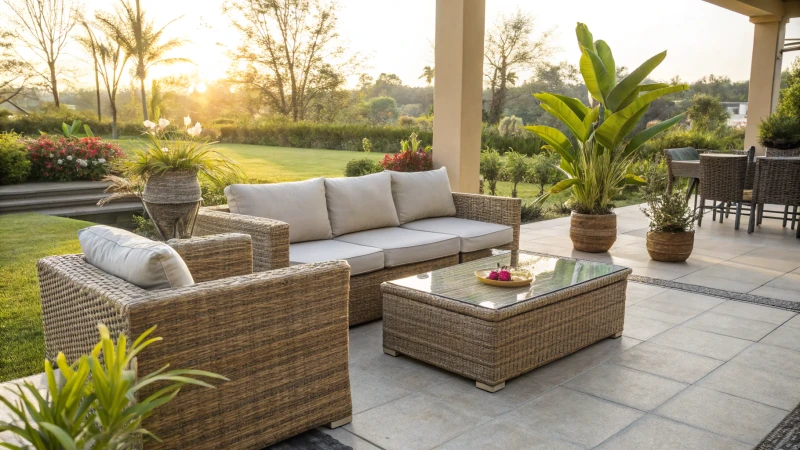
Thinking about rattan for your outdoor furniture? Here are my thoughts!
Rattan often receives praise as a stylish choice for outdoor furniture. But is it really suitable? This post explores its durability and resistance to weather. We also examine how rattan performs when placed outdoors. Discover if it meets your needs. We explore different aspects of rattan as an outdoor material. We will compare it to other options. Find practical maintenance tips to help you with your purchase decision.
When I first looked into outdoor furniture, rattan really grabbed my attention. Its unique charm and flexibility promised style and comfort. But as I learned more, I discovered there was a lot more to know. Rattan is often praised for how it looks. But how does it perform in different weather conditions? Let’s explore these layers together. Maybe we will find out if rattan truly meets the demands of outdoor life.
Rattan is highly durable for outdoor furniture use.True
Rattan is known for its durability, making it suitable for outdoor conditions when properly treated.
Rattan requires extensive maintenance to last outdoors.False
While rattan is stylish, it does require regular maintenance to maintain its quality in outdoor settings.
What Are the Benefits of Using Rattan for Outdoor Furniture?
Have you ever sat on outdoor furniture and felt very relaxed, as if it was designed just for you? For me, that furniture is often rattan. Rattan combines durability, charm and ease of care. This combination attracts my attention. But what specific benefits come with it?
Rattan is a very good choice for outdoor furniture. It stays strong in bad weather. It also looks good in many different settings. Taking care of rattan is easy and doesn’t require much work. Rattan is also friendly to the environment. Sustainable sources produce it. Buyers who care about the planet and want quality really like it for these reasons.
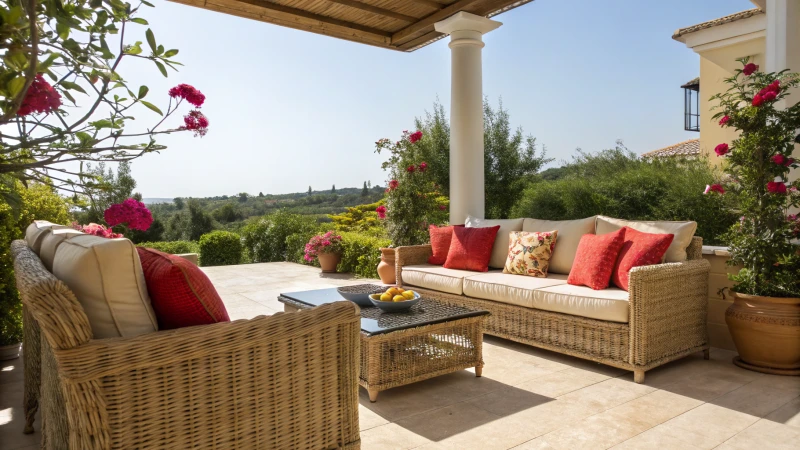
Durability and Weather Resistance
Rattan serves more purposes than just looking nice in outdoor furniture. It is a tough material that stands strong against weather while still looking beautiful. I remember the first time I bought a rattan set for my patio. It changed my outdoor space into a warm and inviting place where friends and family visit to share special moments. Its warmth and flexible look make it a great choice for any outdoor area.
Rattan furniture stays reliable, never disappointing. I have tested my rattan chairs under sunny afternoons and surprising rain showers, and they always stood strong. Their strong durability is why they are great for outdoor use. Unlike some materials that fade or crack in sunlight, rattan stays beautiful over the years with simple care. For those interested in long-term investment, exploring durability features1 of rattan can provide additional insights.
Natural fibers give flexibility that not only extends its life but also adds character. I often tell people that if they want furniture to endure ups and downs, rattan probably is a smart choice. More information about its great durability can be very helpful.
Aesthetic Appeal
Aesthetics played a big role in my love for rattan furniture. Its warm colors and special textures bring life to outdoor spaces. Rattan offers a warm and inviting look that can complement various outdoor settings, from modern patios to rustic gardens.
Rattan’s versatility is another reason I love it. With some colorful cushions or throws, I completely alter the mood of my space. It is like having a blank canvas I can style for each season or my mood. You can learn more about designing with rattan to maximize its visual impact.
I’ve watched rattan adapt from modern patios to cozy garden corners, always adding charm.
Low Maintenance Requirements
Honestly, life gets busy and I rarely have time for intense furniture care. That’s why I value rattan’s low-maintenance quality. A quick wipe with a damp cloth keeps it fresh and inviting.
Many rattan pieces have treatments to resist stains and fading, so I enjoy my outdoor area without worrying about constant care. This ease of maintenance is particularly appealing for busy individuals who wish to enjoy their outdoor spaces without dedicating much time to upkeep. Curious readers might find maintenance tips for rattan useful for keeping rattan in prime condition.
Sustainability and Eco-Friendliness
In our eco-aware world, choosing sustainable materials is very important to me. Rattan shines as an eco-friendly option because it grows rapidly and needs no harmful chemicals for harvesting.
Choosing sustainable rattan lets me enjoy lovely furniture while positively impacting the environment. Knowing my decisions support ethical practices and cut environmental damage feels rewarding; many suppliers adhere to strict environmental standards ensuring their products are not only beautiful but also responsible. To understand more about sustainable sourcing, see eco-friendly furniture options.
Comfort and Versatility
Comfort is crucial for outdoor furniture, and rattan really excels here. With soft cushions increasing comfort, I often lounge outside longer than planned, enjoying the atmosphere.
Moreover, rattan’s lightweight nature allows easy rearrangement of furniture accommodating different outdoor activities and gatherings—from intimate dinners to lively brunches—my rattan furniture suits any occasion perfectly! Discover ways to maximize comfort in outdoor spaces.
Rattan furniture is highly resistant to weather conditions.True
Rattan's durability allows it to withstand sun and moisture, making it ideal for outdoor use.
Rattan requires extensive maintenance compared to wood.False
Rattan needs significantly less upkeep than wood, often just a damp cloth for cleaning.
How Does Rattan Compare to Other Outdoor Materials Like Wicker or Cane?
Have you ever thought about the best material for your outdoor furniture? I know I have! Let’s explore the differences between rattan, wicker and cane. We need to see which one really shines in our outdoor spaces.
Rattan is very strong and lasts a long time. It is great for all weather conditions. Wicker and cane might be lighter. However, they are less strong for outside use. Recognizing these differences is important. It helps when choosing outdoor furniture.
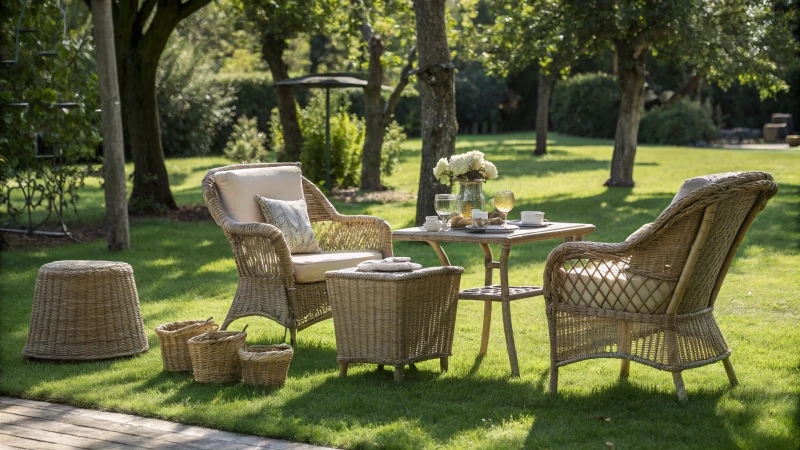
Understanding Rattan
Rattan often causes confusion, but it’s worth knowing about. It is a vine-like plant growing in tropical areas, especially in Southeast Asia. I recall visiting a rattan workshop where skilled artisans crafted not just functional furniture but also art pieces. Rattan’s flexibility and strength suit it for outdoor settings.
Remember, wicker is a weaving method, while rattan is the actual material. This is a crucial distinction! Rattan is treatable to resist weather, keeping its lovely natural color and texture. Such features add warmth to any outdoor area.
For more insights on the properties of rattan2, consider how it stands up against other materials.
Comparing Wicker
Let’s explore wicker. I first thought it was another name for rattan. I learned quickly that it describes a weaving style, not a material. Wicker furniture includes materials like rattan, reed or bamboo.
Wicker tends to be lightweight and has a distinctive look, but its durability varies with the base material used in their construction. For example, synthetic wicker might offer better weather resistance than natural fibers. I bought a lovely wicker chair once, which faded with time; I don’t want to relive that!
Explore more about wicker’s benefits3 and how it compares to rattan for outdoor applications.
The Role of Cane
Cane comes from the outer skin of rattan stems. It looks elegant but outdoors; its durability wavers. Cane furniture is lightweight but often suffers damage outside if not protected.
I had a charming cane chair once that was left in the rain and got damaged—very unfortunate! Rattan proves more robust and suitable for harsh climates.
If you’re curious about cane’s characteristics4, knowing its limits helps in making better choices.
Durability and Weather Resistance
Durability ranks high when choosing outdoor furniture. Rattan excels here, in my experience. Treated rattan resists moisture and UV rays better than cane and typical wicker.
This shows the importance of durable material for outdoor investments as they reward you greatly in the long term.
Here’s a quick comparison:
| Material | Durability | Weather Resistance | Aesthetic Appeal | Customization Options |
|---|---|---|---|---|
| Rattan | High | Excellent | Warm and Natural | High |
| Wicker | Medium | Variable | Classic and Stylish | Medium |
| Cane | Low | Poor | Elegant and Lightweight | Low |
This table highlights how each material performs under different conditions. For further guidance on choosing the right material for your specific needs, check out this resource5. Hopefully, my experiences with these materials help you make informed choices for your beautiful outdoor space.
Rattan is more durable than cane for outdoor furniture.True
Rattan's robust nature makes it a better choice for outdoor use compared to the less durable cane, which is susceptible to wear from the elements.
Wicker is a material like rattan or cane.False
Wicker refers to the weaving technique and not a material itself, meaning it can include rattan but isn't a standalone material.
How Can I Keep My Rattan Outdoor Furniture in Top Shape?
Did you ever watch a beautiful sunset from your patio while sitting on your rattan furniture? Maybe you thought about keeping it looking new. Proper care keeps the beauty. It also increases the lifespan of your treasured pieces.
Clean rattan outdoor furniture often. Use mild soap and water. Protect it from the weather. Use covers or store it indoors. Apply protective treatments every few months. Fix any damage quickly. Following these steps probably keeps your furniture beautiful for a long time. Long life for your furniture is very possible!
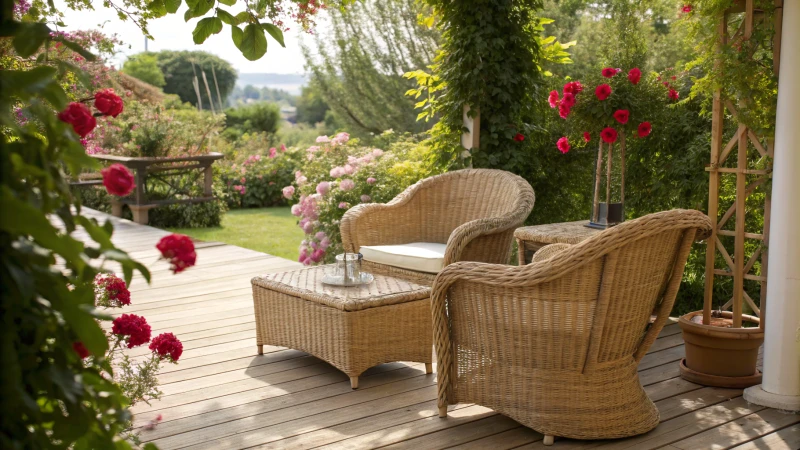
Regular Cleaning
Maintaining the appearance and longevity of your rattan outdoor furniture starts with regular cleaning.
Dusting: A soft brush or cloth helps sweep away dust and dirt. For small spaces, a vacuum with a brush works great.
Washing: About once a month, I use mild soap and water. Harsh chemicals harm the fibers. A gentle scrub with a soft cloth or sponge works wonders.
Rinsing: It’s important to rinse off the soap to avoid buildup, which can attract dirt over time.
Protecting from Weather Elements
Weather harms rattan quickly. I discovered these protection methods:
Covering: I cover the furniture with waterproof covers when not in use. This small step protects it from rain and snow.
Storage: During harsh winters, I store my rattan indoors. Though a bit troublesome, it greatly extends the life of my furniture.
Applying Protective Treatments
I often apply protective treatments to save my rattan furniture:
| Treatment Type | Purpose | Frequency |
|---|---|---|
| UV Protectant | Shields against sun damage | Every 6 months |
| Water Sealant | Prevents moisture absorption | Annually |
| Rattan Conditioner | Maintains luster and flexibility | Every 3 months |
Using the right products will help maintain the aesthetics and functionality of your furniture over time. For instance, UV protectants6 can prevent fading caused by sun exposure.
Repairing Damage
Wear and tear happen no matter how careful we are. I’ve dealt with fraying and scratches. Here’s what I do:
Fraying or Breaking: Spotting fraying strands means using glue or weaving new strands into the damaged area. Quick fixes really help.
Surface Scratches: Fine sandpaper smooths scratches. After buffing, I apply rattan oil for shine.
Professional Repair: For extensive damage, I consult an expert in rattan restoration. It’s wise to get expert help when necessary.
Final Thoughts on Maintenance Practices
Following these tips keeps my rattan furniture functional and beautiful for years. Learning these care methods saves money and lets me enjoy many memories outdoors. Look into detailed care guides to master rattan care – you’ll probably thank yourself later!
Rattan furniture requires regular cleaning to maintain longevity.True
Regular cleaning helps preserve the appearance and durability of rattan furniture, preventing dirt buildup and damage over time.
Covering rattan furniture is unnecessary during bad weather.False
Covering or storing rattan furniture during extreme weather conditions is essential to protect it from damage and extend its lifespan.
Is Rattan Environmentally Friendly and Sustainable for Outdoor Use?
Curious if rattan is a very good eco-friendly option for your garden paradise? Explore its sustainability benefits and environmental effects together!
Rattan is eco-friendly and sustainable for outdoor use. It decomposes naturally and leaves a lower carbon footprint than synthetic materials. Ethically sourced rattan improves its sustainability. This is a responsible choice for people who care about the environment.
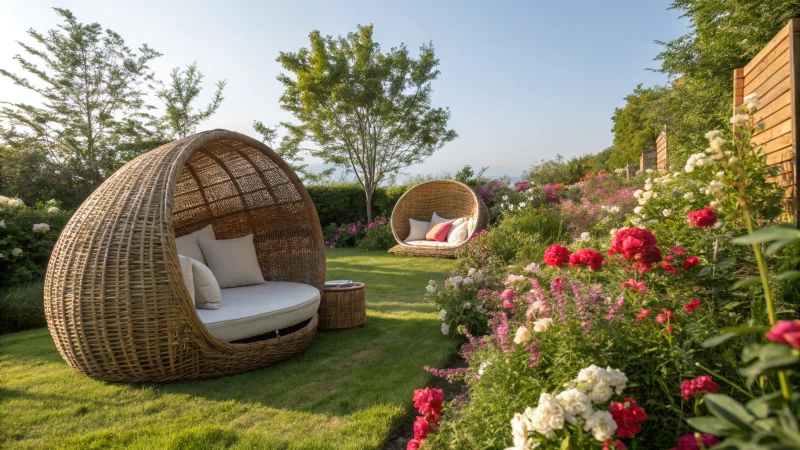
Understanding Rattan’s Environmental Impact
I first found rattan as a material and was immediately fascinated. Its look and sustainability attracted me. Rattan is a climbing palm that grows in tropical areas, making it a renewable resource. Importantly, rattan grows without cutting down our valuable forests, thus minimizing habitat loss.
However, not all methods of harvesting are good. Illegal logging or poor practices could harm our environment. So, I always search for the Forest Stewardship Council (FSC) certification. This certification tells me the rattan comes from well-managed forests. Many buyers prioritize products with this certification to ensure their purchases contribute to sustainable practices. Learn more about sustainable sourcing7.
Rattan’s Biodegradability and Carbon Footprint
Rattan’s biodegradability stands out to me. It resonates with my beliefs. Unlike materials that fill landfills for years, rattan breaks down naturally, which helps to keep the planet healthier. The carbon footprint associated with rattan production is generally lower than that of many synthetic materials used in outdoor furniture.
To illustrate this point, consider the following comparison of carbon footprints:
| Material | Carbon Footprint (kg CO2e per kg) | Biodegradability |
|---|---|---|
| Rattan | 1.0 | Yes |
| Plastic | 6.0 | No |
| Teak Wood | 2.5 | Yes |
This table highlights that choosing rattan not only contributes to less environmental harm but also supports eco-friendly practices. Explore more on rattan vs plastic8.
Durability and Longevity of Rattan Products
Durability plays an important role in outdoor furniture. Many beautiful items have suffered from weather damage; however, rattan, when treated correctly, holds up against weather changes. Its flexibility allows it to endure stress without breaking, giving it a longer lifespan compared to many alternatives.
However, the longevity of rattan products depends on factors such as treatment with protective coatings and regular maintenance. Proper care can extend the life of rattan furniture significantly, making it a cost-effective option in the long run.
Economic Benefits of Choosing Rattan
Choosing rattan is not only good for the planet; it is also a smart economic choice. Because of its fast growth rate and renewability, rattan can be sourced more sustainably than other hardwoods, often leading to lower prices due to reduced scarcity.
Additionally, supporting rattan producers encourages local economies in tropical regions where rattan is harvested and promotes ethical trade practices that empower communities. For buyers like me, understanding these economic benefits is crucial when sourcing materials for premium products. Read more on economic sustainability9.
Rattan is a renewable resource compared to traditional hardwoods.True
Rattan grows abundantly in tropical areas, allowing for sustainable harvesting without deforestation, making it a renewable choice for outdoor furniture.
All rattan products are sourced from sustainably managed forests.False
Not all rattan is ethically sourced; some may come from illegal logging, affecting sustainability. Certification like FSC ensures responsible sourcing.
Conclusion
Rattan offers durability, weather resistance, low maintenance, and aesthetic charm for outdoor furniture. It’s also eco-friendly and sustainable, appealing to environmentally conscious consumers.
-
This link will provide you with comprehensive insights into the durability features of rattan furniture, essential for making informed purchasing decisions. ↩
-
Discover detailed comparisons between rattan, wicker, and cane to make an informed choice for your outdoor furniture needs. ↩
-
Learn about the benefits of wicker in outdoor settings and how it relates to rattan. ↩
-
Gain insights into cane’s characteristics and limitations for outdoor applications. ↩
-
Explore resources that help you select the best material for your specific outdoor needs. ↩
-
Click here for expert tips on maintaining your rattan outdoor furniture to enhance its lifespan and appearance. ↩
-
Clicking this link will provide in-depth insights into sustainable sourcing practices, ensuring your choices align with eco-friendly standards. ↩
-
This link offers a comprehensive comparison between rattan and synthetic materials, helping you understand their environmental impacts better. ↩
-
Explore this link to understand the economic benefits of choosing rattan and how it supports local communities. ↩

